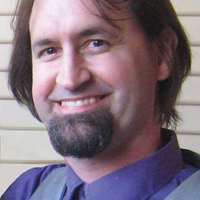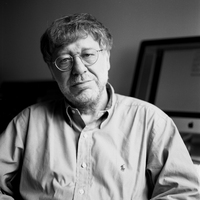
Tom Campbell
Tom A. Campbell received the M. Sc. degree in cognitive science from the University of Manchester in 1997, earning the Ph. D. degree in psychology from the University of Reading in 2000. He qualified as a Docent of cognitive neuroscience at the University of Helsinki in 2007.
At the auditory neuroscience and speech recognition laboratory at University of California Davis (2009-2010), he devised techniques to measure the human rostral brainstem’s response to speech sounds. The approach is published in Ear and Hearing. At the Medical Physics section of The Carl von Ossietzky University of Oldenburg (2012-2013), he developed a system for investigating brainstem responses in persons with binaural cochlear implants. He is a senior research fellow in the Audio Research Group at Tampere University, Finland. His current interests include polyphonic sound event detection and auditory cognitive neuroscience.
Dr. Campbell’s honors and awards include the UC Davis Freshman Seminar Appreciation grant and a Marie Curie Individual Fellowship from the European Commission.
At the auditory neuroscience and speech recognition laboratory at University of California Davis (2009-2010), he devised techniques to measure the human rostral brainstem’s response to speech sounds. The approach is published in Ear and Hearing. At the Medical Physics section of The Carl von Ossietzky University of Oldenburg (2012-2013), he developed a system for investigating brainstem responses in persons with binaural cochlear implants. He is a senior research fellow in the Audio Research Group at Tampere University, Finland. His current interests include polyphonic sound event detection and auditory cognitive neuroscience.
Dr. Campbell’s honors and awards include the UC Davis Freshman Seminar Appreciation grant and a Marie Curie Individual Fellowship from the European Commission.
less
Related Authors
Fiona Kumari Campbell
University of Dundee
Michael Spivey
University of California, Merced
John Sutton
Macquarie University
Mehmet Akif KILIC
Sağlık Bilimleri Üniversitesi
Matt Hall
University of Connecticut
Carlo Semenza
Università degli Studi di Padova
Irina Malkina-Pykh
Saint-Petersburg State University
Zoran Josipovic
New York University
Lyudmila S Mihaylova
The University of Sheffield









Uploads
Papers by Tom Campbell
Binaural cochlear implants can, albeit with individual variability, improve spatial perception. A factor in this variability is the interaural mismatch in the surgical depth of insertion of cochlear implant electrodes. This mismatch necessitates interaural electrode pairing. That pairing facilitates the comparable stimulation of the tonotopic organisation of both cochleas. Here I review the potential for a candidate objective measure for matching interaural electrode pairing. This measure is the electrically evoked binaural interaction component (eBIC). That is, direct stimulation of an electrode in either ear elicits an electrically evoked auditory brainstem response (eABR). The eABR that binaural direct stimulation elicits exhibits a super-additivity beyond the addition of the corresponding two eABRs with direct stimulation of the left and right cochlear separately. That super-additive difference wave is the eBIC. The concept is the higher the amplitude of the eBIC, the better the match of electrodes (Hu et al., 2014). Further investigations (Hu & Dietz, 2015) also reveal the eBIC interaural electrode pairing does not always correspond to other subjective psychophysical interaural electrode-pairing methods.
Questions opento future investigation with larger populations concern which combination of eBIC and subjective measures optimisesinterauralelectrode pairing. These questions are tractable with long-term measuresof auditory spatial perception, speech-in-noise intelligibility,or evenmusical perceptual experience.Parenthetically, the binaural interaction component is subject to top-down attentional control(Ikeda, 2015). Also, learning lexical tones can also affect the brainstem processing of sound(Chandrasekaran, Kraus, & Wong, 2012)as doesmusicianship (Musacchia, Sams, Skoe, & Kraus, 2007).Further open questions thus also concern whether eBIC measures better predict the outcome of differentforms of trainingto promote attention tobinaural cues. A hypothesis is that musical training could promote such attention, as could generalise to attending one talker in a cocktail partysetting.Funding: This work was funded bytheEuropean Union under the Advancing Binaural Cochlear Implant Technology (ABCIT) grant agreement (No. 304912).
Bregman, A.S. (1990). Auditory scene analysis: The perceptual organization of sound. Cambridge, Massachusetts: Bradford Books, MIT Press.
Chandrasekaran, B., Kraus, N., & Wong, P. C. (2012). Human inferior colliculus activity relates to individual differences in spoken language learning. Journal of Neurophysiology,107, 1325–36. doi:10.1152/jn.00923.2011
Hu, H., & Dietz, M. (2015). Comparison of interaural electrode pairing methods for bilateral cochlear implants. Trends in Hearing, 19. doi:10.1177/2331216515617143
Hu, H., Ewert, S., Campbell, T., Kollmeier, B., & Dietz, M. (2014). “An interauralelectrodepairing clinical research system for bilateral cochlear implants,” in 2014 IEEE China Summit and International Conference on Signal and Information Processing (ChinaSIP)(Xi'an), 66–70. doi:10.1109/chinasip.2014.6889203
Ikeda, K. (2015). Binaural interaction in human auditory brainstem response compared for tone-pips and rectangular clicks under conditions of auditory and visual attention.Hearing Research325, 27–34. doi:10.1016/j.heares.2015.02.010
Lokki, T., Pätynen, J., Kuusinen, A., & Tervo, S. (2016).Concert hall acoustics: Repertoire, listening position and individual taste of the listeners influence the qualitative attributes and preferences.Journal of the Acoustical Society of America, 140, 551-62. doi:10.1121/1.4958686
Musacchia,G., Sams,M., Skoe,E., & Kraus,N. (2007).Musicians have enhanced subcortical auditory and audiovisual processing of speech and music.Proc. Natl. Acad. Sci. U.S.A.,104, 15894–98. doi:10.1073/pnas.0701498104
These two preliminary findings, replicated here for the first time with one-and-the-same person, support the “causal informational flow hypothesis”: information ascends from source generators of the eI to the source generators of the eV peak. Accordingly, neuronal afferents from the distal auditory nerve fibres, which generate the eI wave, ascend to subcortical brain regions. These ascending afferents support the transmission of information. A tenable assumption is that this bottom-up informational flow via afferent structural connectivity of the ascending central auditory system thus “causes” (Granger, 1969) the generation of the eV peak by those regions. Such flow via these ascending auditory afferents could serve as a “central gain” (Schaette & McAlpine, 2011) that may take the form of a positive linear relation (Granger, 1969) reflecting the amplification of eI generation at the generation of the eV peak: Stimulation at the apical cochlea causes a higher amplitude eI wave than stimulation at the basal cochlea, thus in turn causing a higher amplitude eV wave with that apical direct stimulation.
A corollary of this causal informational flow hypothesis is the “variable Wave I: Wave V central gain hypothesis”. This hypothesis is that there are individual differences in wave V amplitude gain that the same increase in wave I amplitude produces. An individual gain index of the flow between wave I and wave V generation could, in the longest term, offer in future investigations with more cochlear implant users, a theoretically motivated biomarker for susceptibility to some forms of tinnitus of subcortical origin (Schaette & McAlpine, 2011). The concept is that, in “hidden” loss, neuroplasticity compensates for peripheral loss with a high central gain. Accordingly, phantom auditory perception derives from a high such gain that upregulates electrophysiological noise in the auditory nerve; noise that is unrelated to sound. Interactions with higher neurocognitive and affective aspects of tinnitus are further open to discussion. Funding: This work was funded by the European Union under the Advancing Binaural Cochlear Implant Technology (ABCIT) grant agreement (No. 304912).
Brill, S., Müller, J., Hagen, R. Möltner, A., Brockmeier, S.J., Stark, T., Helbig, S., Maurer, J., Zahnert, T., Zierhofer, C., Nopp, P., Anderson, I., & Strahl, S. (2009). Site of cochlear stimulation and its effect on electrically evoked compound action potentials using the MED-EL standard electrode array. Biomedical Engineering Online, 8:40. doi:10.1186/1475-925X-8-40
Firszt, J., Chambers, R., Kraus, N., & Reeder, R. (2002). Neurophysiology of cochlear implant users I: Effects of stimulus current level and electrode site on the electrical ABR, MLR and N1-P2 response. Ear and Hearing, 23, 502–15. doi:10.1097/01.AUD.0000042153.40602.54
Granger, C. W. J. (1969). Investigating causal relations by econometric models and cross-spectral methods. Econometrica, 37, 424–38. doi:10.2307/1912791
Schaette, R., & McAlpine, D. (2011). Tinnitus with a normal audiogram: physiological evidence for hidden hearing loss and computational model. Journal of Neuroscience, 31, 13452–57. doi:10.1523/JNEUROSCI.2156-11.2011
Binaural cochlear implants can, albeit with individual variability, improve spatial perception. A factor in this variability is the interaural mismatch in the surgical depth of insertion of cochlear implant electrodes. This mismatch necessitates interaural electrode pairing. That pairing facilitates the comparable stimulation of the tonotopic organisation of both cochleas. Here I review the potential for a candidate objective measure for matching interaural electrode pairing. This measure is the electrically evoked binaural interaction component (eBIC). That is, direct stimulation of an electrode in either ear elicits an electrically evoked auditory brainstem response (eABR). The eABR that binaural direct stimulation elicits exhibits a super-additivity beyond the addition of the corresponding two eABRs with direct stimulation of the left and right cochlear separately. That super-additive difference wave is the eBIC. The concept is the higher the amplitude of the eBIC, the better the match of electrodes (Hu et al., 2014). Further investigations (Hu & Dietz, 2015) also reveal the eBIC interaural electrode pairing does not always correspond to other subjective psychophysical interaural electrode-pairing methods.
Questions opento future investigation with larger populations concern which combination of eBIC and subjective measures optimisesinterauralelectrode pairing. These questions are tractable with long-term measuresof auditory spatial perception, speech-in-noise intelligibility,or evenmusical perceptual experience.Parenthetically, the binaural interaction component is subject to top-down attentional control(Ikeda, 2015). Also, learning lexical tones can also affect the brainstem processing of sound(Chandrasekaran, Kraus, & Wong, 2012)as doesmusicianship (Musacchia, Sams, Skoe, & Kraus, 2007).Further open questions thus also concern whether eBIC measures better predict the outcome of differentforms of trainingto promote attention tobinaural cues. A hypothesis is that musical training could promote such attention, as could generalise to attending one talker in a cocktail partysetting.Funding: This work was funded bytheEuropean Union under the Advancing Binaural Cochlear Implant Technology (ABCIT) grant agreement (No. 304912).
Bregman, A.S. (1990). Auditory scene analysis: The perceptual organization of sound. Cambridge, Massachusetts: Bradford Books, MIT Press.
Chandrasekaran, B., Kraus, N., & Wong, P. C. (2012). Human inferior colliculus activity relates to individual differences in spoken language learning. Journal of Neurophysiology,107, 1325–36. doi:10.1152/jn.00923.2011
Hu, H., & Dietz, M. (2015). Comparison of interaural electrode pairing methods for bilateral cochlear implants. Trends in Hearing, 19. doi:10.1177/2331216515617143
Hu, H., Ewert, S., Campbell, T., Kollmeier, B., & Dietz, M. (2014). “An interauralelectrodepairing clinical research system for bilateral cochlear implants,” in 2014 IEEE China Summit and International Conference on Signal and Information Processing (ChinaSIP)(Xi'an), 66–70. doi:10.1109/chinasip.2014.6889203
Ikeda, K. (2015). Binaural interaction in human auditory brainstem response compared for tone-pips and rectangular clicks under conditions of auditory and visual attention.Hearing Research325, 27–34. doi:10.1016/j.heares.2015.02.010
Lokki, T., Pätynen, J., Kuusinen, A., & Tervo, S. (2016).Concert hall acoustics: Repertoire, listening position and individual taste of the listeners influence the qualitative attributes and preferences.Journal of the Acoustical Society of America, 140, 551-62. doi:10.1121/1.4958686
Musacchia,G., Sams,M., Skoe,E., & Kraus,N. (2007).Musicians have enhanced subcortical auditory and audiovisual processing of speech and music.Proc. Natl. Acad. Sci. U.S.A.,104, 15894–98. doi:10.1073/pnas.0701498104
These two preliminary findings, replicated here for the first time with one-and-the-same person, support the “causal informational flow hypothesis”: information ascends from source generators of the eI to the source generators of the eV peak. Accordingly, neuronal afferents from the distal auditory nerve fibres, which generate the eI wave, ascend to subcortical brain regions. These ascending afferents support the transmission of information. A tenable assumption is that this bottom-up informational flow via afferent structural connectivity of the ascending central auditory system thus “causes” (Granger, 1969) the generation of the eV peak by those regions. Such flow via these ascending auditory afferents could serve as a “central gain” (Schaette & McAlpine, 2011) that may take the form of a positive linear relation (Granger, 1969) reflecting the amplification of eI generation at the generation of the eV peak: Stimulation at the apical cochlea causes a higher amplitude eI wave than stimulation at the basal cochlea, thus in turn causing a higher amplitude eV wave with that apical direct stimulation.
A corollary of this causal informational flow hypothesis is the “variable Wave I: Wave V central gain hypothesis”. This hypothesis is that there are individual differences in wave V amplitude gain that the same increase in wave I amplitude produces. An individual gain index of the flow between wave I and wave V generation could, in the longest term, offer in future investigations with more cochlear implant users, a theoretically motivated biomarker for susceptibility to some forms of tinnitus of subcortical origin (Schaette & McAlpine, 2011). The concept is that, in “hidden” loss, neuroplasticity compensates for peripheral loss with a high central gain. Accordingly, phantom auditory perception derives from a high such gain that upregulates electrophysiological noise in the auditory nerve; noise that is unrelated to sound. Interactions with higher neurocognitive and affective aspects of tinnitus are further open to discussion. Funding: This work was funded by the European Union under the Advancing Binaural Cochlear Implant Technology (ABCIT) grant agreement (No. 304912).
Brill, S., Müller, J., Hagen, R. Möltner, A., Brockmeier, S.J., Stark, T., Helbig, S., Maurer, J., Zahnert, T., Zierhofer, C., Nopp, P., Anderson, I., & Strahl, S. (2009). Site of cochlear stimulation and its effect on electrically evoked compound action potentials using the MED-EL standard electrode array. Biomedical Engineering Online, 8:40. doi:10.1186/1475-925X-8-40
Firszt, J., Chambers, R., Kraus, N., & Reeder, R. (2002). Neurophysiology of cochlear implant users I: Effects of stimulus current level and electrode site on the electrical ABR, MLR and N1-P2 response. Ear and Hearing, 23, 502–15. doi:10.1097/01.AUD.0000042153.40602.54
Granger, C. W. J. (1969). Investigating causal relations by econometric models and cross-spectral methods. Econometrica, 37, 424–38. doi:10.2307/1912791
Schaette, R., & McAlpine, D. (2011). Tinnitus with a normal audiogram: physiological evidence for hidden hearing loss and computational model. Journal of Neuroscience, 31, 13452–57. doi:10.1523/JNEUROSCI.2156-11.2011